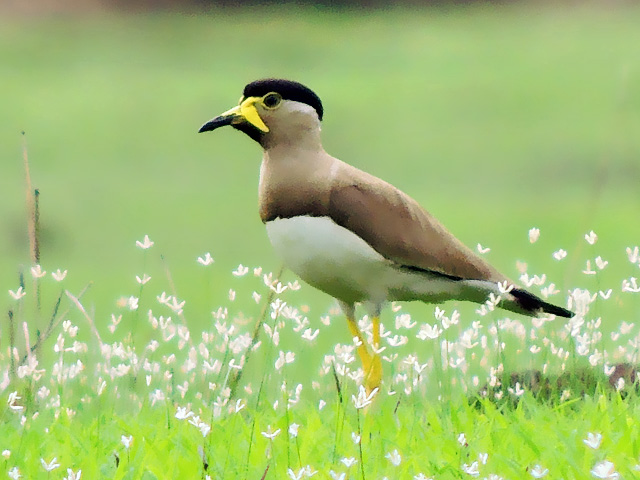Description
From Goa, India
There are no recognized subspecies, but there is a size increase from south to north. They are 260-280mm long with a wing of 192-211mm, bill 23-26mm, tarsus 57-66mm and tail 71-84mm. Juveniles have a brown crown and the sexes are alike but males have slightly longer wings and tarsi. The call is a sharp tchee-it call.[3]
Young bird (7 weeks old)
Habitat and distribution
This species is common in much of India, being seen in a variety of open lowland habitats. It tends to be seen in drier habitats than the red-wattled lapwing, Vanellus indicus. They are found in most parts of India, parts of Pakistan[7] Nepal, Bangladesh and Sri Lanka. They make short distance movements in response to rain but the exact pattern is not known.[4]
These lapwings breed in the dry season with peak breeding in March to May ahead of the monsoons.[8][9] They lay four eggs in a ground scrape.[10] A nest in a clump of grass has been noted as exceptional.[11] Parents visit water and wet their breast feathers ("belly soaking"; they may stay for as much as 10 minutes to soak water[12] ) which may then be used to cool the eggs or chicks.[13] The four eggs typically hatch simultaneously, even though they are laid with a difference of a few days.[14] The nidifugous young are well camouflaged as they forage with the parents. Chicks squat flat on the ground and freeze when parents emit an alarm call. A second brood may be raised, particularly when the first fails and young from a previous brood have been seen along with parent birds incubating a second clutch.[15] Simultaneous courtship displays among several pairs in close proximity has been noted.[16] In one study more than 60% of the nests had 4 eggs-clutches with the rest having 3 eggs. Hatching success was found to be about 27.58% and egg loss was due to predation and nest damage. The incubation period was 27–30 days. When the nests are approached, the incubating bird attempts to move away from the nest without drawing attention to it.[17]
The food of the yellow-wattled lapwing is beetles, termites and other invertebrates, which are picked from the ground.[5] The feather mite Magimelia dolichosikya has been noted as an ectoparasite of this species.[18]



No comments:
Post a Comment
Note: Only a member of this blog may post a comment.